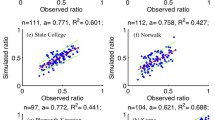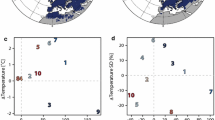Abstract
Changes in snow amount, as measured by the water equivalent of the snow pack (SWE), are studied using simulations of 21st century climate by 20 global climate models. Although the simulated warming makes snow season to shorten from its both ends in all of Eurasia and North America, SWE at the height of the winter generally increases in the coldest areas. Elsewhere, snow decreases throughout the winter. The average borderline between increasing and decreasing midwinter SWE coincides broadly with the −20°C isotherm in late 20th century November–March mean temperature, although with some variability between different areas. On the colder side of this isotherm, an increase in total precipitation generally dominates over reduced fraction of solid precipitation and more efficient melting, and SWE therefore increases. On the warmer side, where the phase of winter precipitation and snowmelt are more sensitive to the simulated warming, the reverse happens. The strong temperature dependence of the simulated SWE changes suggests that projections of SWE change could be potentially improved by taking into account biases in simulated present-day winter temperatures. A probabilistic cross verification exercise supports this suggestion.







Similar content being viewed by others
References
ACIA (2005) Arctic climate impact assessment: scientific report. Cambridge University Press, London, p 1042
Allen MR, Ingram WJ (2002) Constraints on future changes in climate and the hydrologic cycle. Nature 419:224–232
Brier GW (1950) Verification of forecasts expressed in terms of probability. Mon Wea Rev 78:1–3
Christensen JH, Hewitson B, Busuioc A, Chen A, Gao X, Held I, Jones R, Kwon W-T, Laprise R, Magaña Rueda V, Mearns L, Menéndez CG, Räisänen J, Rinke A, Kolli RK, Sarr A, Whetton P (2007) Regional climate projections. In: Solomon S et al (eds) Climate change 2007: the physical science basis. Cambridge University Press, London, pp 847–940
Foster D, Davy R (1988) Global snow depth climatology. USAF Publ. USAFETAC/TN-88/006, Scott Air Force Base, Illinois, p 48
Hosaka M, Nohara D, Kitoh A (2005) Changes in snow coverage and snow water equivalent due to global warming simulated by a 20 km-mesh global atmospheric model. SOLA 1:93–96
Krenke A (1998) Former Soviet Union hydrological snow surveys, 1966–1996. Edited by NSIDC. National Snow and Ice Data Center/World Data Center for Glaciology, Digital media, Boulder
Lemke P, Ren J, Alley R, Allison I, Carrasco J, Flato G, Fujii Y, Kaser G, Mote P, Thomas R, Zhang T (2007) Observations: changes in snow, ice and frozen ground. In: Solomon S et al (eds) Climate change 2007: the physical science basis. Cambridge University Press, London, pp 337–383
Meehl GA, Stocker TF, Collins W, Friedlingstein P, Gaye A, Gregory J, Kitoh A, Knutti R, Murphy J, Noda A, Raper S, Watterson I, Weaver A, Zhao Z-C (2007) Global climate projections. In: Solomon S et al (eds) Climate change 2007: the physical science basis. Cambridge University Press, London, pp 747–845
Mitchell TD, Jones PD (2005) An improved method of constructing a database of monthly climate observations and associated high-resolution grids. Int J Climatol 25:693–712
Mote PW (2006) Climate-driven variability in mountain snowpack in western North America. J Clim 19:6209–6220
Mote PW, Hamlet AF, Clark MP, Lettenmaier DP (2005) Declining mountain snowpack in western North America. Bull Am Meteor Soc 86:39–49
Nakićenović N, Swart R, Eds. (2000) Emission Scenarios. A special report of Working Group III of the Intergovernmental Panel on Climate Change. Cambridge University Press, London, p 599
Räisänen J, Ruokolainen L (2006) Probabilistic forecasts of near-term climate change based on a resampling ensemble technique. Tellus 58A:461–472
Randall DA, Wood RA, Bony S, Colman R, Fichefet T, Fyfe J, Kattsov V, Pitman A, Shukla J, Srinivasan J, Stouffer RJ, Sumi A, Taylor KE (2007) Climate models and their evaluation. In: Solomon S et al (eds) Climate change 2007: the physical science basis. Cambridge University Press, London, pp 589–662
Roesch A (2006) Evaluation of surface albedo and snow cover in AR4 coupled climate models. J Geophys Res 111:D15111, doi:10.1029/2005JD006743
Scherrer SC, Appenzeller C, Laternser M (2004) Trends in Swiss alpine snow days––the role of local and large-scale climate variability. Geophys Res Lett 31, doi:10.1029/2004GL020255
Vavrus S (2007) The role of terrestrial snow cover in the climate system. Clim Dyn 29:73–88
Wilks DS (1995) Statistical methods in the atmospheric Sciences. Academic, New york, p 467
Acknowledgments
We acknowledge the modeling groups for making their model output available as part of the WCRP’s CMIP3 multi-model dataset, the Program for Climate Model Diagnosis and Intercomparison (PCMDI) for collecting and archiving this data, and the WCRP’s Working Group on Coupled Modelling (WGCM) for organizing the model data analysis activity. The WCRP CMIP3 multi-model dataset is supported by the Office of Science, US Department of Energy. This paper benefited from the constructive comments of two anonymous reviewers.
Author information
Authors and Affiliations
Corresponding author
Rights and permissions
About this article
Cite this article
Räisänen, J. Warmer climate: less or more snow?. Clim Dyn 30, 307–319 (2008). https://doi.org/10.1007/s00382-007-0289-y
Received:
Accepted:
Published:
Issue Date:
DOI: https://doi.org/10.1007/s00382-007-0289-y




